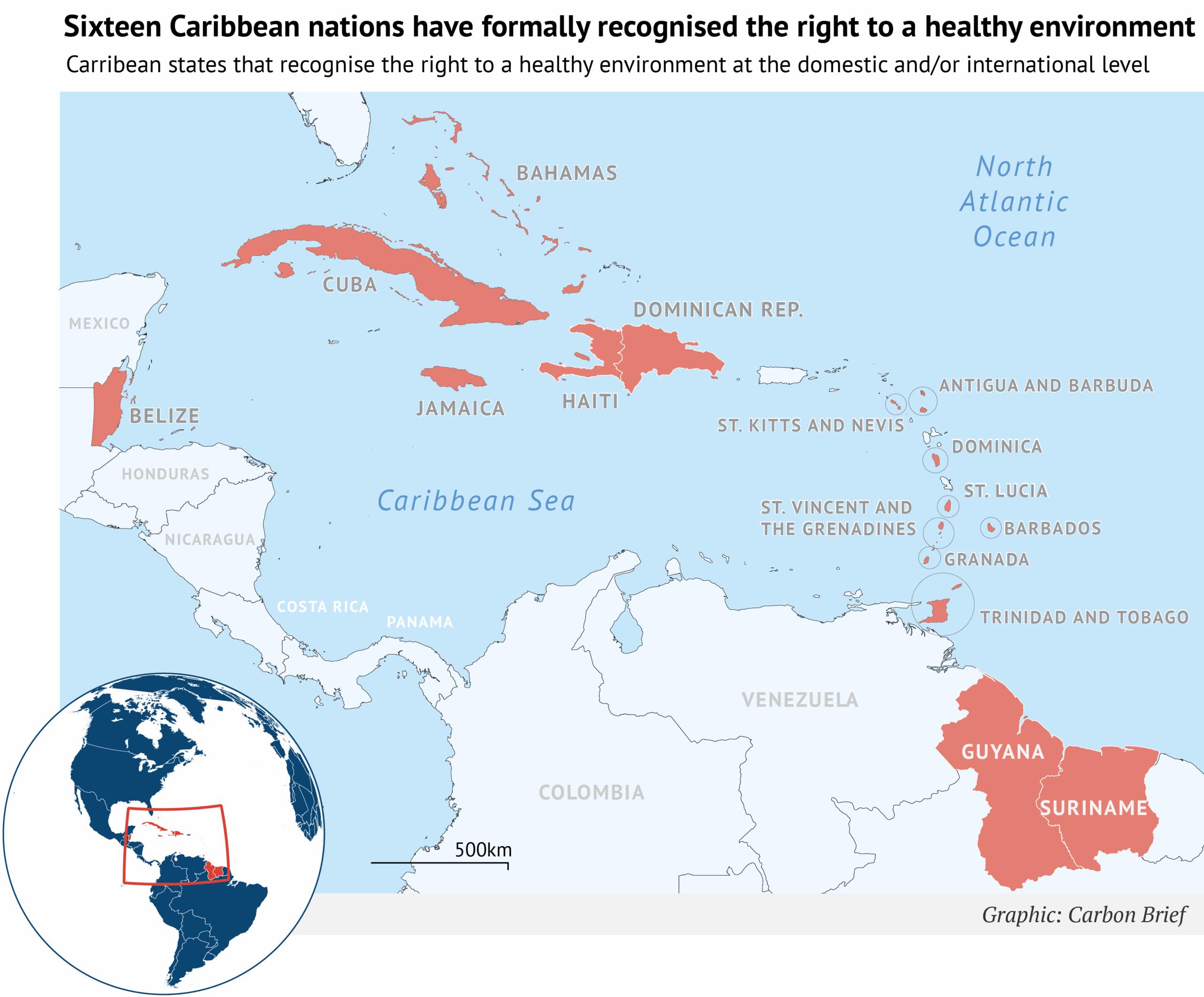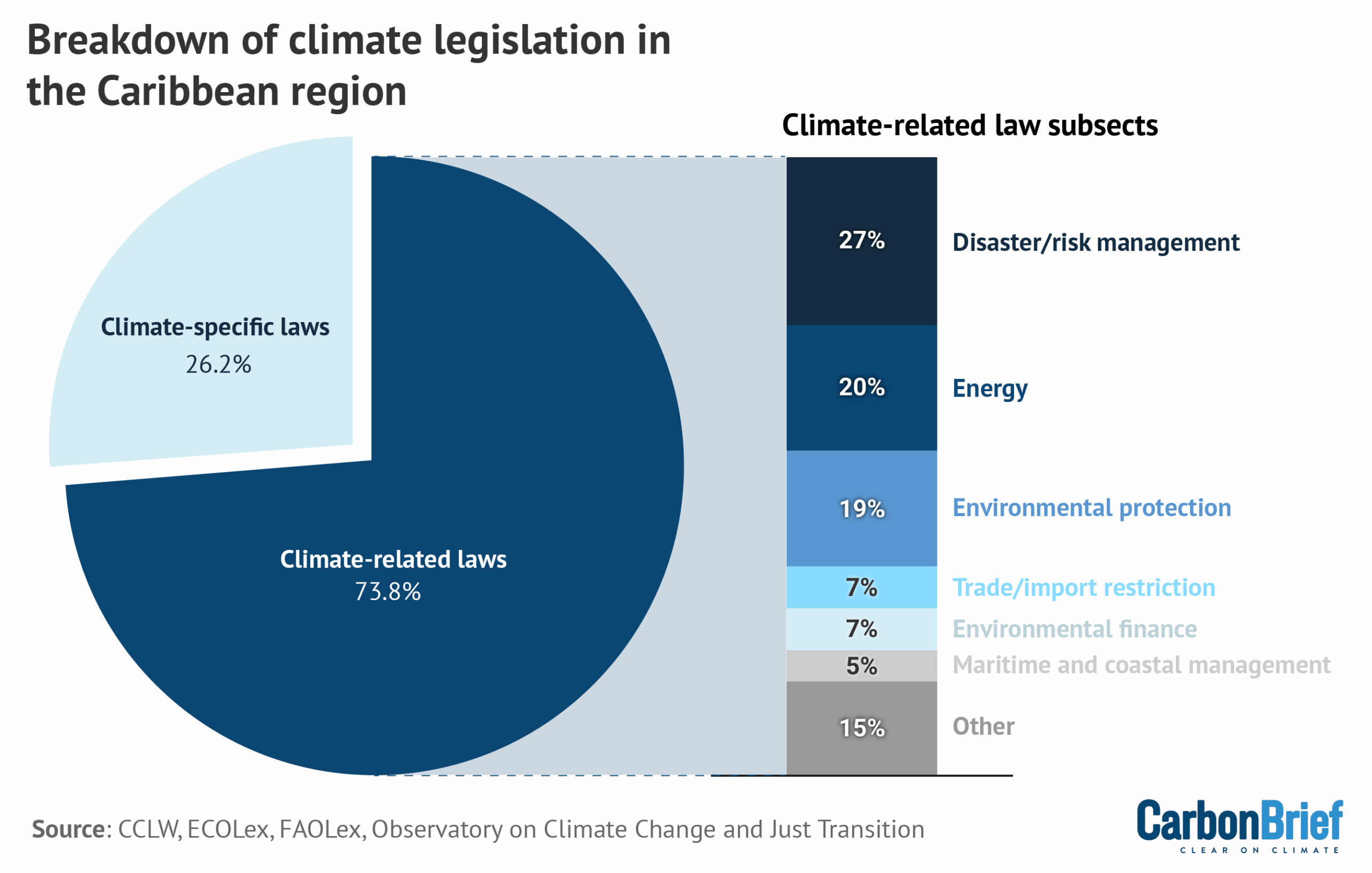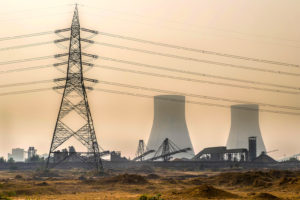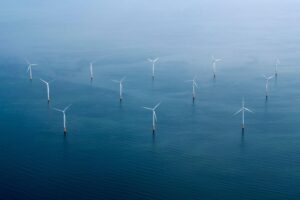Welcome to Carbon Brief’s China Briefing.
China Briefing handpicks and explains the most important climate and energy stories from China over the past fortnight. Subscribe for free here.
Key developments
100% tariffs imposed on Chinese EVs following climate envoy meetings
FIRST MEETING: The recently appointed Chinese and US climate envoys Liu Zhenmin and John Podesta met in Washington last week with an aim to build on the “Sunnylands statement” that had restored engagement between presidents Xi Jinping and Joe Biden at their summit last year, the Hong Kong-based South China Morning Post reported. At the meeting, Podesta raised issues with Liu including “Chinese overcapacity in solar and battery manufacturing, steel production and coal power”, according to Reuters, adding that “the tone of the talks continued to be cordial”. State-run newspaper China Youth Daily reported comments from Chinese foreign ministry spokesperson Wang Wenbin saying that the US “expresses willingness to strengthen cooperation with China in addressing climate change”.
100% TARIFFS: Just after Liu’s US visit concluded, Biden announced significant new tariffs on a range of Chinese imports, reported Bloomberg. The outlet quoted Biden saying: “When you [China] make tactics like this, you’re not competing, it’s not competition, it’s cheating. And we’ve seen damage here in America.” According to a breakdown published by Reuters, tariffs on Chinese electric vehicles (EVs) will quadruple to 100% (plus a separate 2.5% tariff), while solar cell tariffs will double to 50%, lithium-ion EV battery tariffs will increase from 7.5% to 25% and tariffs on critical minerals rise from nothing to 25% this year.
MEDIA REACTION: New York Times’ columnist Paul Krugman supported the increased tariffs, saying: “Why not just buy cheap Chinese batteries? Political economy…The Biden administration was able to get large subsidies for renewable energy only by tying those subsidies to the creation of domestic manufacturing jobs. If those subsidies are seen as creating jobs in China instead, our last, best hope of avoiding climate catastrophe will be lost.” However, another New York Times’ comment article by economists Gernot Wagner and Conor Walsh asked the US to not “slam the door on inexpensive Chinese electric vehicles”. Bloomberg columnist David Fickling commented that “Chinese clean tech is not the enemy”, adding “from all the talk of Chinese ‘overcapacity’ coming out of Washington, you might think that the problem of addressing climate change had already been solved…We’ll need all [western nations’] industrial might – plus that of China, and a whole host of countries besides – to get there.” An editorial in the Economist called the tariffs a “bad policy, worse leadership”, saying they “will bring underappreciated economic harms to America and the world”.
CHINA REACTION: The Chinese foreign minister Wang Yi said that the tariffs are the “most typical form of bullying in the world today”, adding “it shows that some people in the US have reached the point of losing their minds in order to maintain their unipolar hegemony”, Reuters reported. State-run newspaper China Daily quoted foreign ministry spokesperson Wang Wenbin saying that the US is “making double standards by justifying its own subsidies and exports, while accusing other countries’ subsidies and exports as ‘unfair’ and ‘overcapacity’”. State broadcaster CCTV reposted a statement by the Ministry of Commerce which says that the US move is “a clear example of political manipulation”.
State-backed media disputes US ‘overcapacity’ argument
PEOPLE’S DAILY: The Communist party-affiliated People’s Daily published comments under the nom-de-plume “Zhong Caiwen”, which is likely linked to the party’s Central Financial and Economic Affairs Commission, on 7, 8, 9, 10, 12 and 13 May about China’s manufacturing production capacity under the background of “the US trying its best to exaggerate the so-called ‘overcapacity’ of China’s new energy resources”. The articles claimed that the “overcapacity arguments are designed to ‘curb and suppress China’s superior industries’”, “ignore[ing] the benefits that Chinese products bring to global consumers”, while stressing the contributions China made to tackling climate change.
ECONOMIC DAILY: Meanwhile, state-run media outlets Xinhua, Guangming Daily and Economic Daily carried similar opinions. The Economic Daily, which according to its own introduction, plays an “important role for the communist party’s Central Committee and the State Council in guiding the public opinion towards economy”, ran the headline, “Refuting ‘the theory of overcapacity in new energy’”, on its 6 May frontpage and, “Refuting ‘the theory of overcapacity in new energy’ again”, on the frontpage of 13 May. The two articles argued that the rapid growth in China is “not blind expansion”, but is based on the “urgent need to reduce global carbon emissions” and that the US uses it as “an excuse for more trade barriers”.
DOMESTIC FACTORS: Founder of H&S Capital and former news editor of BBC News Chinese Howard Zhang told Carbon Brief that this “sudden media storm” came “at a time of rising discontent over economic downturn and huge youth unemployment [in China]”. He added that “these anti-West reports help to divert public opinions and reinforce the government’s conspiracy theory that the West, led by the US, is trying to ‘stop China from rising up’ and is trying to ‘choke China off’”. Zhang acknowledged that China “does have a point”, but added it was “worth noting that these reports do not really report on Western concerns objectively and these reports are still mainly targeting the domestic audience”.
INTERNATIONAL OUTLOOK: Isabel Hilton, founder of London-based NGO Dialogue Earth (formerly China Dialogue) told Carbon Brief that the reason behind China arguing its “predominance in key industrial areas was not the result of unfair subsidies”, but because “it is unlikely that either the EU or the US will allow important industrial sectors to be undermined in what they see as unfair completion, with all the political and economic damage that would follow. Hence, the Chinese need to argue that it is not unfair.” Hilton, a visiting professor at King’s College London, added that a key point made by the Chinese media commentary was “China’s model of industrial development is no different from that of Western industrialised countries and that, further, they obey WTO rules and do not restrict or protect their own market…we can debate quite a lot of this, especially the market access point”.
Xi rebuts overcapacity and endorses climate cooperation during visiting Europe
OVERCAPACITY TENSIONS: On 5 May, president Xi commenced a five-day visit to Europe, which he began by meeting French president Emmanuel Macron and European Commission president Ursula von der Leyen, Agence France-Presse reported. The newswire quoted von der Leyen saying the EU “cannot absorb massive over-production of Chinese industrial goods”. In comments covered by the People’s Daily, Xi responded that “there is no such thing as ‘China’s overcapacity problem’”. Meanwhile, China and France signed the “Sino-French joint declaration on strengthening cooperation on biodiversity and the oceans: Kunming-Montreal to Nice”, to deepen cooperation on biodiversity protection, People’s Daily reported.
PRE-READ: Le Figaro published an article by Xi ahead of his arrival in France, in which he noted that Sino-French cooperation “spearheaded cooperation in aviation and nuclear energy”. He added: “Our two countries can deepen cooperation on innovation and jointly promote green development…The Chinese government supports more Chinese companies in investing in France. And we hope that France will ensure that they operate in a fair and equitable business environment.” State newswire Xinhua published an official English translation of the piece.
OTHER COUNTRIES: Meanwhile, Xi also visited Serbia and Hungary, where the South China Morning Post said he “upgraded relations with China’s two closest allies in Europe”. German chancellor Olaf Scholz did not meet Xi in person, but told journalists at a press conference that there are “many overlaps” between China and western automotive manufacturers, Reuters reported. State-run outlet Reference News quoted the German federal minister for digital affairs and transport saying “we don’t want to close off markets” to Chinese EVs.
EU SOLAR PROBE: Following the EU’s launching of a probe into Chinese solar companies last month, Longi and Shanghai Electric withdrew tenders to supply a Romanian solar park in “the latest sign that the EU’s new anti-subsidy powers are having a deterrent effect” on companies suspected of receiving Chinese subsidies, the Financial Times said. It quoted the EU internal markets commissioner saying the regulation ensures “foreign companies which participate in the European economy do so by abiding [by] our rules”.
China’s low-carbon energy boost
NEW DATA: China’s state broadcaster CCTV reported that China’s electricity generation from wind and solar increased 25% year-on-year in the first quarter of 2024. In the same period, electricity generated from coal declined. According to data from National Energy Administration (NEA), the total solar capacity in the first quarter of 2024 reached 45.7 gigawatts (GW), China Energy Net reported. In addition, China’s low-carbon electricity capacity will be enlarged with the State Council approving the construction of a 2GW offshore solar project at Lianyungang city, economic newswire Jiemian reports. Once being constructed, it will connect with eight existing nuclear power plants and become a 10GW “mega” renewable energy project, added the outlet.
NEW RESEARCH: A new paper covered by Carbon Brief found that China’s rising electricity demand can be met more cheaply through a combination of solar plus battery storage than by building new coal capacity. Carbon Brief also covered a study by the China Energy Transformation Program, a project under China’s Energy Research Institute, that finds electrification, greater energy efficiency and a low-carbon power system could help China develop a net-zero emissions energy system by 2055, five years earlier than its “dual carbon” goal planned.
Spotlight
Interview: China’s renewables ‘pave the way to rapidly reduce coal reliance’
A new report by Australia-based thinktank Climate Energy Finance argues that China could reach its “dual carbon” climate goals earlier than planned.
Carbon Brief interviews the author of the report to find out more. The questions and their answers are edited for length and clarity. The whole interview is available on Carbon Brief’s website.
Carbon Brief: Your report concluded that China’s coal power output will soon peak and decline – despite rising coal capacity – thanks to the rapid rise of clean energy sources. How widely do you think that potential tipping point is understood, both within China and internationally?
Xuyang Dong: This potential is not being understood or acknowledged enough both within China and internationally. China is prioritising energy security over the need to reduce coal-use…Concurrently, China is increasing renewable energy capacity at a staggering pace that far outstrips every other nation on the planet.
Internationally, news headlines continue to emphasise that China is building new coal-fired power plants, leading to a lack of confidence about China’s commitment to decarbonising its national electricity grid…However, the picture is more positive when we look at installed capacity. At the end of March this year, 53% of China’s installed capacity was zero-emissions.
CB: If China is to announce more ambitious climate goals and expand renewable energy like you suggested in the report, in your opinion, what are the barriers?
XD: We are aware there are concerns over China’s land use as a major constraint for building more wind and solar farms. We have run a case study on a 1.5GW solar project being built in the Tengger Desert in Ningxia Province. The project has 3.5 million solar modules installed, and only took up 0.1% of the total desert. In our model, we estimate that China needs to install a total of 5,405GW of new solar capacity to reach its dual-carbon targets and that may require only 11% of a total land area of the Gobi Desert, a neighbouring desert to Tengger.
The real challenge is that… more transmission lines are needed to maximise the renewable energy generation potential of China’s desert areas, and to resolve China’s land use constraints in the east coast.
CB: What do you think about policy support?
XD: I think being more ambitious in the overall climate target would be a good start… Considering its political system is “top-down”, a more ambitious target could help the central government to give out more mandates, build better transmission lines and distribute the generated power into the areas that are needed.
Internationally, China needs to align with other developed countries to take its responsibilities as the leading renewable superpower, and the carbon price would be an important policy lever… A further driver would be for other nations to also catch up with China’s staggering renewable expansion, and start to emulate its speed and scale, so there will be no excuse left for China to do less.
CB: What do you think about China’s “new three” – solar, batteries and EV – and how they help China in energy transition and economy?
XD: The “new three” has played a very huge part in China’s economic growth [in 2023]…I know there are a lot of concerns about this overcapacity in the industry, such as in the EU and the US, and I think for China to address the concerns over industrial overcapacity, it needs to, first, stimulate domestic demand and deployment of solar and wind farms, energy storage systems buildout and EV sales. Secondly, China could use its cheap renewable exports to help emerging markets and developing economies to build more renewable energy capacity, boosting and accelerating the global energy transition. Finally, it should be collaborating on joint ventures with European and US investors to build local factories.
Watch, read, listen
ENVIRONMENT ‘SPY’: The South China Morning Post reported that China’s top spy agency claimed two foreign NGOs and foundations had stolen “environmental data” from China.
FLOODING AI: A new artificial intelligence (AI) model was developed by Chinese scientists to forecast flood risks and monitor hydrological conditions even in basins lacking hydrological records, another South China Morning Post article reported.
NEA COMMENT: The Communist party-affiliated magazine Current Affairs Report published an article written by the head of China’s National Energy Administration (NEA), Zhang Jianhua, about “high-quality development of new energy”.
G7’S STRATEGIES: EU-China environmental cooperation specialist Arvea Marieni wrote a comment on G7’s climate strategies for China’s state broadcaster CGTN.

In April 2024, nearly half of cars sold in China were electric vehicles (EVs) or plug-in hybrids (PHEVs), which are known collectively as “new-energy vehicles” (NEVs). According to figures from the China Passenger Car Association (CPCA), NEVs made up 44% of sales in April, up from 34% a year earlier and just 4% during the same month in 2020.
New science
Impact of flowering temperature on lychee yield under climate change: a case study in Taiwan
Climate Services
A decline in the number of cooler days as a result of climate change could make existing varieties of lychee “unsuitable for cultivation in production areas in southern Taiwan”, a new study says. With some lychee farmers in Taiwan already experiencing economic losses as the climate warms, the researchers project a decline in lychee yields per hectare of 12-35% by the end of the century.
China Briefing is compiled by Wanyuan Song and Anika Patel. It is edited by Wanyuan Song and Dr Simon Evans. Please send tips and feedback to china@carbonbrief.org
The post China Briefing 16 May 2024: Biden’s 100% tariffs on Chinese EV; State media pushback; Xi’s Europe trip appeared first on Carbon Brief.
Greenhouse Gases
DeBriefed 10 October 2025: Renewables power past coal; Legacy of UK’s Climate Change Act; Fukushima’s solar future
Welcome to Carbon Brief’s DeBriefed.
An essential guide to the week’s key developments relating to climate change.
This week
Renewables overtake coal
‘HISTORIC FIRST’: Renewables have overtaken coal to become the world’s leading source of electricity for the first six months of this year in a “historic first”, BBC News said. The analysis, from the thinktank Ember, found the world generated “almost a third” more solar power in the first half of the year, compared with the same period in 2024, while wind power grew by “just over 7%,” reported the Guardian.
HEAVY LIFTING: According to the report, China and India were “largely responsible for the surge in renewables”, while the US and Europe “relied more heavily on fossil fuels,” the Guardian wrote. China built more renewables than every other country combined in the first half of this year, the newspaper added.
CONTINENTAL SHIFTS: A second report from the International Energy Agency (IEA) predicted a “surge” in global wind and solar capacity by 2030, but shaved 5% off its previous forecast, the Financial Times said. The IEA revealed that India is set to become the second-largest growth market for renewables after China, “with capacity expected to increase 2.5 times by 2030”, Down to Earth reported. The IEA also upped its forecast for renewables in the Middle East and north Africa by 23%, “helped by Saudi Arabia rolling out wind turbines and solar panels”, but halved the outlook for the US, the FT noted.
Around the world
- EV BOOM: Sales of electric and hybrid cars made up “more than half” of all new car registrations in the UK last month, a new record, according to data from the Society of Motor Manufacturers, reported BBC News.
- BANKING COLLAPSE: A global banking alliance launched by the UN to get banks to slash the carbon footprint of their loans and investments and help drive the transition to a net-zero economy by 2050 has collapsed after four years, Agence France-Press reported.
- CUTS, CUTS, CUTS: The Trump administration plans to cut nearly $24bn in funding for more than 600 climate projects across the US, according to documents reviewed by the Wall Street Journal.
- PEOPLE POWER: A farmer, a prison guard and a teacher were among those from the Dutch-Caribbean island Bonaire who appeared at the Hague on Tuesday to “accuse the Netherlands of not doing enough to protect them from the effects of climate change”, Politico reported.
400,000
The number of annual service days logged by the US National Guard responding to hurricanes, wildfires and other natural disasters over the past decade, according to a Pentagon report to Congress, Inside Climate News reported.
Latest climate research
- Politicians in the UK “overwhelmingly overestimate the time period humanity has left to bend the temperature curve”, according to a survey of 100 MPs | Nature Communications Earth and Environment
- Fire-driven degradation of the Amazon last year released nearly 800m tonnes of CO2 equivalent, surpassing emissions from deforestation and marking the “worst Amazon forest disturbance in over two decades” | Biogeosciences
- Some 43% of the 200 most damaging wildfires recorded over 1980-2023 occurred in the last decade | Science
(For more, see Carbon Brief’s in-depth daily summaries of the top climate news stories on Monday, Tuesday, Wednesday, Thursday and Friday.)
Captured

The UK’s Climate Change Act, landmark legislation that guides the nation’s response to climate change, is increasingly coming under attack from anti-net-zero right-leaning politicians. In a factcheck published this week, Carbon Brief explained how the UK’s Climate Change Act was among the first comprehensive national climate laws in the world and the first to include legally binding emissions targets. In total, 69 countries have now passed “framework” climate laws similar to the UK’s Climate Change Act, with laws in New Zealand, Canada and Nigeria among those explicitly based on the UK model. This is up from just four when the act was legislated in 2008. Of these, 14 are explicitly titled the “Climate Change Act”.
Spotlight
Fukushima’s solar future
This week, Carbon Brief examines how Fukushima helped to recover from nuclear disaster by building solar farms on contaminated farmland.
On 11 March 2011, an earthquake off the pacific coast of Japan caused 15m-tall waves to crash into the eastern region of Tōhoku, killing 19,500 people and injuring a further 6,000.
In the aftermath, flooding at the Fukushima Daichi nuclear power plant caused cooling systems to fail, leaching radioactive contaminants into the soil and leading to a major nuclear incident.
Some 1,200km2 around the site was restricted and up to 100,000 people were evacuated – in some cases forever.
In the years following, Japan entered a fraught debate about nuclear energy.
In 2010, nuclear power provided 25% of Japan’s electricity, but, in the years following the disaster, its 54 nuclear reactors were taken offline.
Successive governments have fought over reintroducing nuclear power. Today, some 14 reactors are back online, 27 have been permanently closed and another 19 remain suspended. (Japan’s newly-elected prime minister Sanae Takaichi has promised to make nuclear central to her energy strategy.)
Against this backdrop, Fukushima – a prefecture home to 1.8 million people – has emerged as a surprise leader in the renewables race.
In 2014, the Fukushima Renewable Energy Institute (FREA) opened with the twin goals of promoting research and development into renewable energy, while “making a contribution to industrial clusters and reconstruction”.
That same year, the prefecture declared a target of 100% renewable power by 2040.
Contaminated land
“A lot of these communities, I know, were looking for ways to revitalise their economy,” said Dr Jennifer Sklarew, assistant professor of energy and sustainability at George Mason University and author of “Building Resilient Energy Systems: Lessons from Japan”.
Once evacuation orders were lifted, however, residents in many parts of Fukushima were faced with a dilemma, explained Skarlew:
“Since that area was largely agricultural, and the agriculture was facing challenges due to stigma, and also due to the soil being removed [as part of the decontamination efforts], they had to find something else.”
One solution came in the form of rent, paid to farmers by companies, to use their land as solar farms.
Michiyo Miyamoto, energy finance specialist at the Institute for Energy Economics and Financial Analysis, told Carbon Brief:
“The [Fukushima] prefecture mapped suitable sites early and conducted systematic consultations with residents and agricultural groups before projects were proposed. This upfront process reduced land-use conflicts, shortened permitting timelines and gave developers clarity.”
As a result, large-scale solar capacity in Fukushima increased to more than 1,300 megawatts (MW) from 2012 to 2023, according to Miyamoto. Moreover, installed renewable capacity now exceeds local demand, meaning the region can run entirely on clean power when conditions are favourable, Miyamoto said.
Today, aerial pictures of Fukushima reveal how solar panels have proliferated on farmland that was contaminated in the nuclear disaster.

Charging on
Last year, 60% of Fukushima’s electricity was met by renewables, up from 22% in 2011. (The country as a whole still lags behind at 27%.)
And that is set to grow after Japan’s largest onshore windfarm started operations earlier this year in Abukuma, Fukushima, with a capacity of 147MW.
The growth of solar and wind means that Fukushima is already “ahead of schedule” for its 2040 target of 100% renewable power, said Miyamoto:
“The result is a credible pathway from recovery to leadership, with policy, infrastructure and targets working in concert.”
Watch, read, listen
OVERSHOOT: The Strategic Climate Risks Initiative, in partnership with Planet B Productions, has released a four-part podcast series exploring what will happen if global warming exceeds 1.5C.
DRONE WARFARE: On Substack, veteran climate campaigner and author Bill McKibben considered the resilience of solar power amid modern warfare.
CLIMATE AND EMPIRE: For Black history month, the Energy Revolution podcast looked at how “race and the legacies of empire continue to impact the energy transition”.
Coming up
- 12 October: presidential elections, Cameroon
- 13-14 October: Pre-COP, Brasilia, Brazil
- 13-18 October: World Bank Group/IMF annual meetings, Washington DC
- 14-17 October: 2nd extraordinary session of the Marine Environment Protection Committee at the International Maritime Organisation, London
- 15-16 October: Circle of Finance Ministers report
Pick of the jobs
- Buckinghamshire Council, principal climate change officer | Salary: £49,354-£51,759. Location: Aylesbury, Buckinghamshire
- Sustainable NI, sustainable business lead | Salary: £60,000. Location: Belfast, Northern Ireland
- Dialogue Earth, South Asia managing editor | Salary: £1,875 per month. Location: South Asia
DeBriefed is edited by Daisy Dunne. Please send any tips or feedback to debriefed@carbonbrief.org.
This is an online version of Carbon Brief’s weekly DeBriefed email newsletter. Subscribe for free here.
The post DeBriefed 10 October 2025: Renewables power past coal; Legacy of UK’s Climate Change Act; Fukushima’s solar future appeared first on Carbon Brief.
Greenhouse Gases
Guest post: How Caribbean states are shifting climate legislation
The Caribbean region is among the most vulnerable to climate change, despite historically contributing less than half of one percent of global greenhouse gas emissions.
Rising sea levels, extreme heat and more frequent and intense storms – such as the 2024 Hurricane Beryl, which made landfall in Grenada – pose urgent and growing threats to the small island states, coastal nations and overseas territories that comprise the Caribbean region.
With global progress to address climate change still too slow, Caribbean countries are taking matters into their own hands by enacting more robust legislation to help protect against climate risks.
In a new study published in the Carbon and Climate Law Review, we identified 78 climate laws and legally binding decrees across 16 Caribbean states, as well as two constitutional references to climate change and a growing recognition of the right to a healthy environment.
Our analysis suggests that, together, these developments are not only enhancing resilience, but also positioning Caribbean states as influential actors in the global climate arena.
Caribbean climate laws on the rise
Climate governance in the Caribbean has expanded significantly in recent years. In the past decade, countries such as Cuba and the Dominican Republic have embedded climate obligations and programmatic guidelines into their national constitutions.
At the same time, legislative recognition of the human right to a healthy environment is gaining momentum across the region. Six Caribbean nations now affirm the right in their constitutions, while 15 have recognised it through international instruments, such as the UN Council, UN Assembly and the Escazu Agreement, as shown in the figure below.

More recently, there has been a notable rise in targeted, sector-specific climate frameworks that go beyond broader environmental statutes.
Saint Lucia stands out as the only country with a climate framework law, or a comprehensive national law that outlines long-term climate strategies across multiple domains. Meanwhile, several other Caribbean governments have adopted climate-specific laws that focus on individual sectors, such as energy, migration and disaster management.
According to our analysis, more than a quarter of climate-relevant legislation in the region – comprising 21 laws and legally binding decrees – now has an explicit focus on climate change, as illustrated in the chart below.
Our research suggests that this represents an ongoing shift in legislative focus, reflecting changes in how climate legislation is being structured in one of the world’s most climate-vulnerable regions.

Caribbean nations are also advancing legal reforms to structure and institutionalise climate finance and market mechanisms directly into domestic law, aligned with Article 6.2 of the Paris Agreement.
For example, the Bahamas has introduced provisions for carbon credit trading, while Antigua and Barbuda, Barbados and Grenada have established national climate financing mechanisms to support mitigation and adaptation efforts.
Some states, including Belize and Saint Kitts and Nevis, have incorporated regional bodies such as the Caribbean Community Climate Change Centre – the climate arm of the intergovernmental Caribbean community organisation CARICOM – into national frameworks. This indicates an increasing alignment between regional cooperation and domestic law.
In addition to the influx of regulations specifically addressing climate change, Caribbean nations are also legislating broader environmental issues, which, in turn, could provide increased resilience from climate impacts and risks, as shown in the graph above.
Key trends in these types of climate-related laws include the expansion of disaster risk management governance, which addresses national preparedness for climate-induced weather events or related catastrophes. Likewise, energy law is an increasingly prominent focus, with countries including Antigua and Barbuda and Saint Vincent and the Grenadines integrating renewable energy and energy efficiency goals into national climate governance.
More broadly, many Caribbean nations have adopted wide-ranging and comprehensive environmental laws, many of which were developed in alignment with existing climate commitments. In combination, these legal developments reflect a dynamic and evolving climate governance landscape across the region.
Proactive vs reactive approaches
Despite general alignment with these broader regional trends, our research reveals distinct developmental pathways shaping domestic climate regulation.
In the eastern Caribbean, for example, we saw both proactive, long-term planning strategies and reactive, post-disaster reforms.
Saint Lucia’s multifaceted approach to climate resilience evolved steadily over the course of more than a decade. During this time, the country developed numerous adaptation plans, strengthened cross-sectoral coordination and engaged in institutional climate reforms in areas such as energy, tourism, finance and development.
More recently, the passage of Saint Lucia’s Climate Change Act in 2024 marked a milestone in climate governance, by giving legal force to the country’s obligations under the UNFCCC, the Kyoto Protocol and the Paris Agreement – making Saint Lucia one of the few small island states to incorporate global climate commitments into domestic law.
Our research indicates that this strategy has not only positioned the country as a more climate-resilient nation, but also solidified its access to international climate financing.
In contrast, Dominica’s efforts evolved more rapidly in the aftermath of Hurricane Maria in 2017, which destroyed over 200% of the country’s GDP. The storm’s impacts were felt across the country and hit particularly hard for the Kalinago people – the Caribbean’s last Indigenous community – highlighting the role of socioeconomic disparities in shaping climate vulnerability and resilience.
In response, the government passed the Climate Resilience Act, creating the temporary Climate Resilience Execution Agency for Dominica (CREAD).
Beyond establishing an exclusively climate-focused institution, the act aimed to embed resilience into governance by mandating the participation of vulnerable communities – including Indigenous peoples, women, older people and people with disabilities – in shaping and monitoring climate resilience projects.

As noted in a recent statement by the UN special rapporteur on Climate Change, Dr Elisa Morgera, these frameworks underscore the government’s ambition to become the world’s first “climate-resilient nation.”
Although challenges persist, Dominica’s efforts demonstrate how post-disaster urgency can drive institutional change, including the integration of rights and resilience into climate governance.
Uneven progress and structural gaps
Despite significant progress, our research shows that several key opportunities for climate governance across the Caribbean continue to exist, which could enable improvements in both resilience and long-term ambition.
The region’s legal landscape remains somewhat heterogeneous. While Saint Lucia has enacted a comprehensive climate framework law, the rest of the region lacks similar blanket legislation. This includes some states that entirely lack climate-specific laws, instead relying on related laws and frameworks to regulate and respond to climate-related risks.
Other nations have yet to adopt explicit disaster-risk management frameworks, leaving Caribbean populations vulnerable before, during and after climate emergencies. Most have yet to enshrine the right to a healthy environment at the national level.
Our research suggests that outdated legal frameworks are further limiting progress in addressing current climate risks. Because many of the longer-standing environmental laws in the region were adopted well before climate policy became a mainstream concern, some fail to address the nature, frequency and intensity of modern climate challenges, such as sea-level rise, tropical storms, wildfires, floods, droughts and other impacts.
More broadly, many Caribbean climate laws include limited integration of gender equity, Indigenous rights and social justice. As Caribbean nations such as Grenada and the Dominican Republic begin to link climate resilience with these issues, the region has an opportunity to lead by example.
Ultimately, capacity and resource constraints persist as significant barriers to implementation and adaptation.
The Caribbean region faces debt that exacerbates ongoing development challenges, a burden made heavier by the repeated economic shocks of climate-related disasters. Along with regional debt-for-resilience schemes, increased funding from high-emitting countries to support adaptation measures in climate-vulnerable nations – as endorsed under the Paris Agreement – is likely to be critical to ensuring the region’s climate laws can be executed effectively.
Global implications of Caribbean climate law
Our research suggests that Caribbean countries are outpacing other regions in terms of the scope and ambition of their climate laws. This legislation has the potential to serve as a model for climate-vulnerable nations worldwide.
Continuing efforts in the region show that legal frameworks in the field can not only drive resilience, embed rights and strengthen claims to international finance, but also highlight how regional cooperation and diplomacy can enhance global influence.
These findings demonstrate that innovation in climate law need not wait for action from major emitters, but can instead be led by those on the front lines of climate change.
The post Guest post: How Caribbean states are shifting climate legislation appeared first on Carbon Brief.
Guest post: How Caribbean states are shifting climate legislation
Greenhouse Gases
IEA: Renewables have cut fossil-fuel imports for more than 100 countries
More than 100 countries have cut their dependence on fossil-fuel imports and saved hundreds of billions of dollars by continuing to invest in renewables, according to the International Energy Agency (IEA).
It says nations such as the UK, Germany and Chile have reduced their need for imported coal and gas by around a third since 2010, mainly by building wind and solar power.
Denmark has cut its reliance on fossil-fuel imports by nearly half over the same period.
Renewable expansion allowed these nations to collectively avoid importing 700m tonnes of coal and 400bn cubic metres of gas in 2023, equivalent to around 10% of global consumption.
In doing so, the fuel-importing countries saved more than $1.3tn between 2010 and 2023 that would otherwise have been spent on fossil fuels from overseas.
Reduced reliance
The IEA’s Renewables 2025 report quantifies the benefits of renewable-energy deployment for electricity systems in fossil fuel-importing nations.
It compares recent trends in renewable expansion to an alternative “low renewable-energy source” scenario, in which this growth did not take place.
In this counterfactual, fuel-importing countries stopped building wind, solar and other non-hydropower renewable-energy projects after 2010.
In reality, the world added around 2,500 gigawatts (GW) of such projects between 2010 and 2023, according to the IEA, more than the combined electricity generating capacity of the EU and US in 2023, from all sources. Roughly 80% of this new renewable capacity was built in nations that rely on coal and gas imports to generate electricity.
The chart below shows how 31 of these countries have substantially cut their dependence on imported fossil fuels over the 13-year period, as a result of expanding their wind, solar and other renewable energy supplies. All of these countries are net importers of coal and gas.

In total, the IEA identified 107 countries that had reduced their dependence on fossil fuel imports for electricity generation, to some extent due to the deployment of renewables other than hydropower.
Of these, 38 had cut their reliance on electricity from imported coal and gas by more than 10 percentage points and eight had seen that share drop by more than 30 percentage points.
Security and resilience
The IEA stresses that renewables “inherently strengthen energy supply security”, because they generate electricity domestically, while also “improving…economic resilience” in fossil-fuel importer countries.
This is particularly true for countries with low or dwindling domestic energy resources.
The agency cites the energy crisis exacerbated by Russia’s invasion of Ukraine, which exposed EU importers to spiralling fossil-fuel prices.
Bulgaria, Romania and Finland – which have historically depended on Russian gas for electricity generation – have all brought their import reliance close to zero in recent years by building renewables.
In the UK, where there has been mounting opposition to renewables from right-wing political parties, the IEA says reliance on electricity generated with imported fossil fuels has dropped from 45% to under 25% in a decade, thanks primarily to the growth of wind and solar power.
Without these technologies, the UK would now be needing to import fossil fuels to supply nearly 60% of its electricity, the IEA says.
Other major economies, notably China and the EU, would also have had to rely on a growing share of coal and gas from overseas, if they had not expanded renewables.
As well as increasing the need for fossil-fuel imports from other countries, switching renewables for fossil fuels would require significantly higher energy usage “due to [fossil fuels’] lower conversion efficiencies”, the IEA notes. Each gigawatt-hour (GWh) of renewable power produced has avoided the need for 2-3GWh of fossil fuels, it explains.
Finally, the IEA points out that spending on renewables rather than imported fossil fuels keeps more investment in domestic economies and supports local jobs.
The post IEA: Renewables have cut fossil-fuel imports for more than 100 countries appeared first on Carbon Brief.
IEA: Renewables have cut fossil-fuel imports for more than 100 countries
-
Climate Change2 years ago
Spanish-language misinformation on renewable energy spreads online, report shows
-
Climate Change2 months ago
Guest post: Why China is still building new coal – and when it might stop
-
Climate Change Videos2 years ago
The toxic gas flares fuelling Nigeria’s climate change – BBC News
-

 Greenhouse Gases1 year ago
Greenhouse Gases1 year ago嘉宾来稿:满足中国增长的用电需求 光伏加储能“比新建煤电更实惠”
-
Greenhouse Gases2 months ago
Guest post: Why China is still building new coal – and when it might stop
-

 Climate Change1 year ago
Climate Change1 year ago嘉宾来稿:满足中国增长的用电需求 光伏加储能“比新建煤电更实惠”
-

 Carbon Footprint2 years ago
Carbon Footprint2 years agoUS SEC’s Climate Disclosure Rules Spur Renewed Interest in Carbon Credits
-
Renewable Energy3 months ago
US Grid Strain, Possible Allete Sale












